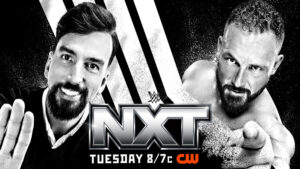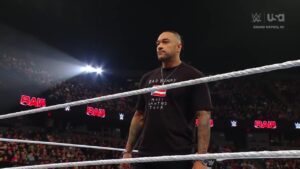Backstage is a respite, holding a peaceful darkness before reaching the blinding lights. Fan’s excited energy is carried into every corner of the theatre, and their screaming voices all blend together. Hitting the runway the performer struts to their mark, and their gait tells the audience exactly who they are.
While fans stretch their hands toward them, they either graze their palm with a smile or brush them away with an eye roll. When the performer sheds their sequin-covered coat, they reveal a skin-tight, bejeweled uniform with stockings, and everyone can feel that the show is about to start. Their hair is used as a weapon, flipping around and creating shapes. Painted faces become blurred from the lights beaming down on them and the sweat on their brow. One might wonder, is this about professional wrestlers or drag queens?
From Charles Wright covered in purple satin and furs, to Randy Orton dousing himself in body oil and posing, to how Dustin Rhodes lacquered himself in gold and black and performed a strip tease, there are undeniable similarities between these two worlds.
The performers in wrestling embody their character’s gender identity, whether it be masculine, feminine, or nonconforming, in ways that evoke a range of emotions from their audience, including attraction, repulsion, and inspiration. They blend elements of tragedy and comedy seamlessly, often within the same performance. It’s striking how similar this is to the art of drag, yet only one of these industries is facing a current threat.
Given the current political climate and the rise of anti-LGBTQ+ legislation in the United States, it’s important to highlight the parallels between drag and professional wrestling. By acknowledging these connections, we can work towards dispelling the fear and misunderstanding that surrounds drag.
As our mores around gender have shifted and the queer community has continued to gain tangible rights over the last fifteen years, conservatives are doubling down to dehumanize them. The fight for anti-drag legislation in the United States is a gossamer-thin veil over the far rights’ true mission; to attack transgender people’s identities, rights, and personhood.
These bills are reviving a façade that feels as old as time, “protect children from x, y, and z.” There is a reoccurring throughline that echoes from decades past with hysteria surrounding gay men, stranger danger, HIV, and satanic panic. Right now, the moral panic is being reborn in the legislative actions that impact transgender people all over the United States. Drag queens are enduring a chunk of the repercussions of this fear-mongering.
As fans of wrestling, in response to the level of dehumanization being thrust on queer communities, it’s important to accept and celebrate that wrestling is drag. Professional wrestling and drag performance both seek to create spectacles as expressions of art and sport. Both are considered lowbrow entertainment while at the same time are avant-garde, simultaneously feeding off of and into elements of camp. But most importantly, they are both propelled ever forward by fans that stand before them with their hands in the air.
Drag, Character, and Theatre
Drag, specifically, is a vast concept that spans hundreds of years, contexts, and cultures. It is so much a part of human expression, it can be hard to think of something that isn’t considered drag. While the concept of performing gender seems complex, it is something every person does every day of their life.
The truth is that the gender spectrum spans as long as the night sky, and as deep as the Mariana Trench. Biological sex has never truly indicated the way a person shows their gender, especially since the binary has shifted and twisted across cultures more times than can be recorded. Like the photo of baby Franklin Delano Roosevelt in a dress, gender presentation has historically been subject to the time someone lives in.
In the world of entertainment and performance, clothing and makeup play a crucial role in expressing gender. Performers don costumes and apply makeup to create a unique look that accentuates their individuality and brings their character to life. This practice is common among showgirls, actors, bodybuilders, influencers, and many other professionals. By donning their signature attire, performers reveal their true selves to their audience. In wrestling and drag, these elements are particularly important as they contribute to the overall artistic expression of the performance.
Even when stripping them of their fineries, both wrestlers and drag queens use their bodies to translate stories, live on a stage. The book “Performance and Professional Wrestling” refers to wrestling as “…the business of theatre,” and drag is in the same trade. This could be because, throughout the last hundred years, the pair have been featured in circuses and vaudeville shows where subversion was capitalized, from women’s feats of strength to men’s demonstrations of beauty.
And, like wrestling, drag has been seen throughout history in a vast array of circumstances. Drag can be seen in Kabuki theatre, old Hollywood movies, Shakespearean-era plays, 1990s club kids, Norwegian black metal, world politics, and of course professional wrestling, among other things.
Paint, Glitter, and Blood
Gender performance is woven through wrestling, like a film on your hands that can’t be washed away. Wrestlers often dub themselves the biggest boy in the room and show off their flexed bodies covered by only a loin cloth and saturated in oil like Charles Bronson fighting correctional officers. Wrestling’s hypermasculinity, although the norm, is still gender performed for the masses.
When looking at fantastical wrestling characters in the US, many dolled themselves up in drag for decades without it being labeled as such. For example, the Undertaker, the Boogeyman, Sting, and the Ultimate Warrior relied on paint and clothing (or lack thereof) to help them stand out and show off their persona. The Brood were sleek vampires, with fangs and all. In their white cotton ruffled shirts and leather pants, they were a bloody concoction of “Interview With a Vampire” and “Blade.”
Glenn Jacobs did drag as Kane for over twenty years, leaning into the drama as he and the aforementioned Undertaker acted out a Cain and Abel-inspired storyline of fire, murder, and revenge. All of this was done while wearing tight spandex, a wig styled in what we now refer to as the wet look, and black raccoon eyeliner underneath a mask. Now Jacobs is a mouthpiece of right-wing sentiment and supports politicians who want to take away rights from LGBTQIA+ communities. We all live many lives.
Both draw inspiration from the same sources and rely on pop culture references as their driving force, making their similarities apparent. Old Hollywood starlets, showgirls, film, the fabulosity of 1970s and 80s gameshows, television, and more. With these inspirations, the feather, sparkle, and sequin industries will never go out of business with professional wrestling and drag still kicking. The throughline in this seems to be camp, which is an exaggerated, flamboyant, satirical yet somehow sincere type of dress, or essence. From Susan Sontag’s seminal Notes on Camp:
“Camp taste draws on a mostly unacknowledged truth of taste…[and] consists in going against the grain of one’s sex. What is most beautiful in virile men is something feminine; what is most beautiful in feminine women is something masculine. . . . Camp taste for the androgynous is something that seems quite different but isn’t: a relish for the exaggeration of sexual characteristics and personality mannerisms. For obvious reasons, the best examples that can be cited are movie stars. The corny flamboyant female-ness of Jayne Mansfield, Gina Lollobrigida, Jane Russell, Virginia Mayo; the exaggerated he-man-ness of Steve Reeves, Victor Mature. The great stylists of temperament and mannerism, like Bette Davis, Barbara Stanwyck, Tallulah Bankhead, Edwige Feuillière…”
The fascination with luxurious wrestling attire may have originated with Gorgeous George, a prominent wrestler of the 1940s. He was known for his impeccably coiffed hair and extravagant, floor-length gowns. Everywhere he went, the ornate coats he wore exuded the scent of Chanel No. 5 perfume.
Many wrestlers took inspiration and leaned into the campy, eccentric pieces of wrestling. Randy Savage wore bright colors, feathers, and hats, and emoted like a telenovela star. A fun aside, even the song Macho Man by The Village People was a tribute in part to Savage. Koko B. Ware carried a parrot to the ring, his hair matching the bird’s feathers, while he sported lamé and sequins. Ric Flair emerged onto the runway with coats encrusted with rhinestones, diamonds, and crystals. Inspired by Buddy Rogers, his perfectly bleached hair, glowed on the television. He proudly displayed his wealth to fans, boasting about his cashmere clothing and diamond-studded Rolex watch.
Read More: The Pioneers: Sandy Parker – First Black Women’s and LGBTQIA+ World Champion
There are also clear examples of wrestlers who have purposefully blurred the line between wrestling and drag. While luchadors have been known for the intricacies of their masks, clothes, and overall wrestling styles, exoticos are some of the clearest representations of drag in wrestling. Swinging to the subversive side of gender expression, they are the meeting point between the two industries. A 1940s wrestler named Dizzy Davis is considered one of the first exoticos in Mexico, and he upset the usual virtues for a wrestler by being primped and pampered by his valet, ringside. Now, people of varying gender identities perform as exoticos. The consistent theme for the entertainers is that they see the machismo in wrestling and blow it a kiss.
Adrian Street became the “Sadist in Sequins” (a title of one of Streets’ autobiographies) with his white-blonde locks. In the essay, “King of The Ring, and Queen of it Too” author Greer quotes Street saying he was, “…a nancy-boy who was tougher than he had any right to be, a confusing spanner in the works of masculinity.” Street refused to play the role of a mere cog in the hyper-masculine machine, and in doing so, commanded attention.
Another Jean Harlow/Marilyn Monroe platinum blonde of wrestling was Goldust. His entire essence was a direct inspiration from showgirls, pole dancers, and drag queens. Like Street and the exoticos, his actions destabilized the gender of those around him. He would wear feathered boas with a painted face and would perform strip teases. Goldust once hit the runway in a baby’s diaper, another time he came to the ring clad in leather, walking on fours like a dog with Luna Vachon as his wrangler.
A Modern Mixing
There have been a few wrestling drag queens, but none so on the nose as Choke Hole, a show based out of New Orleans. The promoters were quoted in Pro Wrestling Illustrated, Choke Hole “…places a queer lens on the traditionally machismo world of wrestling, using drag and queer performance to intensify inherently flamboyant and camp elements of professional wrestling.” Through layers of lip sync performances, playing into their personas, and wrestling matches, these entertainers subvert expectations, marry drag and wrestling together in a cocktail, then splash it in your face.
Drag queens have been quicker to see the similarities between drag and wrestling. The popular TV show RuPaul’s Drag Race, a competition series, had a challenge in their fourth season called “W.T.F.! Wrestling’s Trashiest Fighters,” where the queens put on a fun match (that is quite impressive when you find out their training was slim). Years later another contestant, Daya Betty, centered a challenge around her love of wrestling and spoke about how it was a personal and sexual awakening for her.
Even one of the most brutal wrestlers of the 1990s has a connection to drag. New Jack was known as someone who went over the edge and could be a frightening presence in a wrestling ring. Some of his more controversial decisions in the squared circle have been reported in the Vice docuseries, “Dark Side of the Ring.” Somewhat ironically, his child is a Baltimore-based drag queen who goes by Washington Heights. To quote the Vice article that interviews Heights, she says of her first exposure to wrestling, “I was fascinated by the entrance music, the costumes, the flashiness, the big personalities, the fireworks. That’s pretty much everything that I’m doing except drag queens don’t slam each other on the floor…”
Real World Implications
When it comes to transgender wrestlers, some travel the fifty United States for work, and as of this writing, forty-six have anti-LGBTQIA+ bills in debate, which have dangerous implications. Add to that, there are already massive problems with healthcare in the United States, and the wrestling industry is an example of its issues. Despite being a combat sport, wrestlers are often denied the opportunity for health insurance coverage by their employers due to being classified as independent contractors or work-for-hires. The independent scene cannot afford to provide insurance, and World Wrestling Entertainment (WWE) intentionally fights to not have to. With further attempts at health care cuts for transgender folks, trans wrestlers have compounded issues forced on them.
Transgender people are disproportionally the victims of violence. Black trans women, and trans women of color especially have been put in dangerous situations by powerful people, and the structures they work within. Overall, there have been blatant attempts to devalue and dehumanize trans people. For example, their intentions can be seen in the baseless controversy stirred up about transgender athletes in the world of sports, and unfortunately, the repercussions can be felt in the pro wrestling community. Sonny Kiss, Nyla Rose, and more represent the trans community in the sport, and unfortunately, in All Elite Wrestling (AEW), Rose has endured transphobia from the audience, with an incident prompting security to remove individuals for hateful signs and rhetoric.
Read More: Recognizing Women’s Wrestling Trailblazers
In early April of this year at a wrestling convention, IMPACT wrestler Gisele Shaw reported online that she experienced a verbal assault from WWE Hall of Famer Rick Steiner. His actions toward a fellow wrestler are inexcusable and cruel to someone who should be protected in that space. Steiner was not permitted to return to the convention the following day because of the incident. After the verbal attack, Shaw took to Twitter on Trans Day of Visibility, stating that other WWE legends just sat and watched him dehumanize her, but she would not let him stifle her. She emphasizes these transphobic acts keep happening when people stand on the sidelines and “do not take any action.” Recently WWE legend Kevin Nash released a statement saying Steiner’s actions were wrong. When people like him continue to take action, change can be a tangible outcome.
To Put A Bow On It
In response to the legislation across the US, previous RuPaul’s Drag Race contestant Denali tweeted “If ya’ll wanna get rid of drag, you gotta get rid of WWE.” This rings very true and sums up this piece in fewer words. As a fan of wrestling, it is currently important to see the similarities, and if you don’t, question why not.
Professional wrestling and drag even both transcend the capitalistic philosophy of “just a job.” Passion is born, lives, and immortalizes itself within these industries.
Similar to their core, the two professions are fringe interests that some people simply just do not understand. And that’s not a bad thing, it’s not meant for everyone. Drag is an act of gender defiance, actuality, queering, and affirmation. All the while putting on a good show. With wrestling, there will always be those who cannot absorb the satire, silliness, or rough edges. Even its sweetest parts can be too saccharine for some. But that’s okay. They should just get out of the audience and make room for those with their hands in the air.






